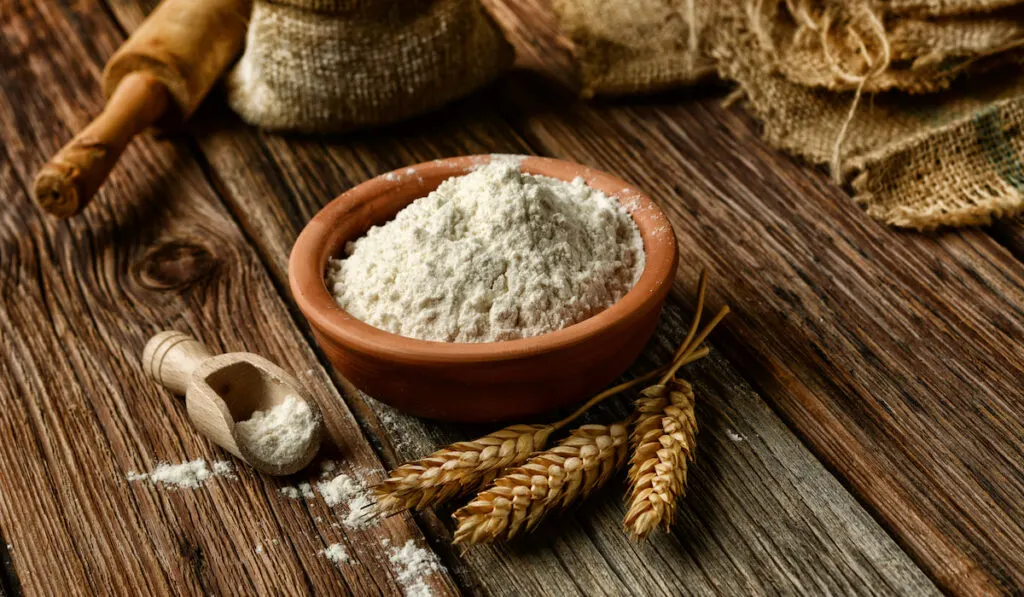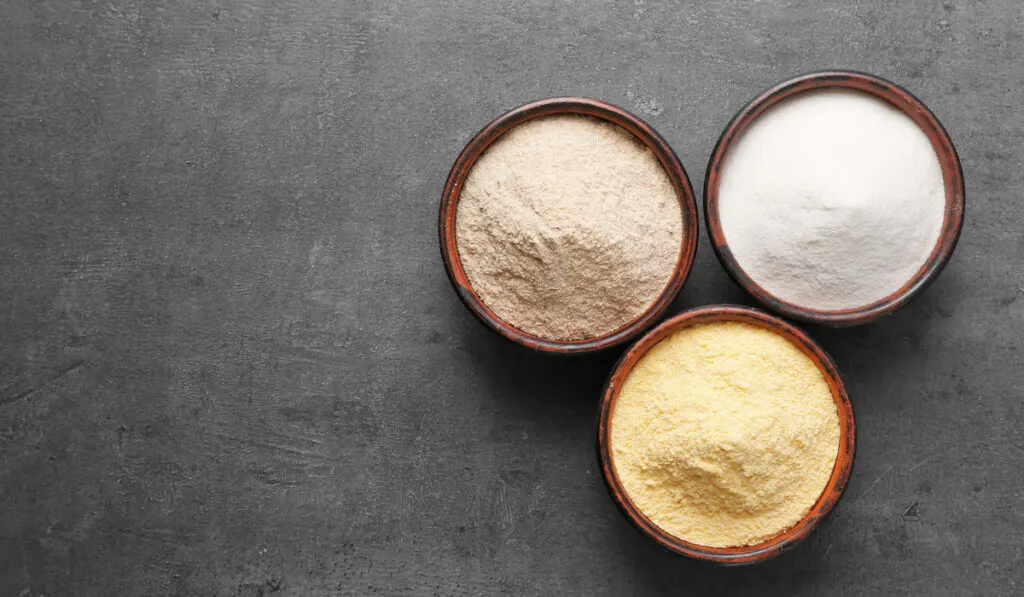One of the most vital ingredients in bread making is flour. The type of flour one uses in making bread determines the overall quality of the bread.
Flour contains two types of proteins that give bread its form. The first is glutenin which is responsible for chewiness and elasticity. The other protein is gliadin which provides extensibility – the ability of the pastry to rise and stretch.

These proteins require water to connect and create the bread, supporting a structure known as gluten. Gluten holds the carbon dioxide bubbles from fermentation in place until baking is complete.
Aside from the talk about flour and flour protein, we will discuss the different types of bread flour in this article. We also talk about the yeast content of flour.
Types of Bread Flour
Below is a list of flours used in bread making:
All-Purpose Flour
All-purpose flour is probably the most commonly used flour. Its gluten content is between 9 and 11%.
All-purpose flour is derived when soft wheat and hard wheat are combined. It is available in two varieties: unbleached and bleached.
Unbleached All-purpose flour is naturally aged to bleach the yellow pigment of freshly milled flour and to oxidize the proteins. Unbleached all-purpose flour contains more nutrients.

Bleached flour is quickly aged using chlorine dioxide gas. The bleaching process removes certain chemicals that hinder gluten development. After the bleaching process, some bleached flours are enriched with nutrients, like B vitamins, calcium, and iron.
These nutrients are added to match the nutritional value of unbleached flour. You can use both flours in your bread recipes without having to worry.
Bread Flour
Bread flour is used in making some of the best loaves of bread all over the world. The protein content of bread flour is between 12 and 14%, making it perfect for baking yeasted bread.
With its high protein content, bread flour contains more gluten. It makes the bread dough light and more elastic.
The finished product ends up having an airy and chewy texture. The level of kneading required when using bread flour is different from that of other flour types.
Whole Wheat Flour
Whole wheat flour is a product of whole wheat berry, germ, and oil-rich bran.
This flour has the highest gluten content, which goes as high as 16%. Whole wheat flour offers fine to coarse textures and nutty flavors, which will eventually bake into chewy and crusted bread.
Bread made from whole wheat tends to be dense and heavy because it is not as smooth as all-purpose or bread flour. Whole wheat flour also contains hulls which make the gluten strands less effective.

White Whole Wheat Flour
White whole wheat flour comes from a sweet, new, light-colored white spring wheat. It has a gluten percentage of around 12%, which makes it an excellent all-purpose flour substitute. Its nutrition value is similar to whole wheat, but it has a milder taste.
Durum Wheat Flour
Durum wheat flour is the flour with the highest protein content. The gluten formed when water is added to this flour is not elastic. So it has to be combined with other flours.
When combining durum wheat flour with other flours to make bread, it can be up to 26% protein.
A perfect example of a durum-wheat-flour bread is Pugliesi.
Rye Flour
Rye flour has enough gluten content to make a yeasted loaf on its own. When you use rye flour, a richly flavored, dark, and dense bread is produced. However, if you intend to make a lighter loaf, mix rye flour with wheat flour.
Rye flour has a delicious fruity flavor. For this reason, it is ideal for making sweet, quick bread like scones and fruited cakes.
Whole grain rye does not have many uses. But kibbled rye is used for multi-seeded loaves.
Pumpernickel Flour
Pumpernickel flour is coarsely ground whole rye flour. Bread made from pumpernickel flour is called Pumpernickel bread. The loaves are usually intensely flavored, dense, and dark.
Does Flour Have Yeast in It?
Flour does not have yeast in it naturally, it must be added by someone. In some cases, however, flour may capture some wild yeast on its surface.
This happens when such flour is exposed to air. However, during flour processing, most of the wild yeast is polished off. So little or nothing is left.
It is worthy to note that some flours are self-rising. But this does not mean they contain yeast. Instead, self-rising flour contains baking powder and salt, which facilitate leavening.
What Types of Flour Are Yeast-Free?
Bread flour, whole grain flour, self-rising flour, all-purpose, and basically all types of flour are yeast-free. This holds true until yeast is added to them.
Does Wheat Flour Have Yeast?
Yeast is a living organism contained in the air. So, exposed to air, some of it may settle on the wheat flour. But, that aside, wheat flour does not naturally contain yeast. Except when the yeast is added by the manufacturer, or it settles in from the air.

Anything Special You Need to Do With Specialty Flours vs. Regular Flour?
Pastry Flour vs. Regular Flour
Pastry flour is a specialty flour with low protein content and is perfect for baked goods.
Pastry flour has a protein content of about 8-9%, with regular flour having 10-12%. When making pastries like quick bread, a low protein content means a flakier and lighter dough. In such cases, pastry flour is ideal.
However, pastry flour is not ideal for all types of pastries. Cinnamon buns, for instance, have a dense and soft dough. A texture that can only be achieved using regular flour.
So, you have to be careful with each recipe. Pastry flour may work well with homemade puff pastry dough. But it may not work well with other recipes.
Bread Flour vs. Regular Flour
With a protein content of 11-13%, bread flour is sturdier than regular flour. But you can substitute regular flour for bread flour. The protein content of bread flour favors the production of gluten.
Always remember that the increased protein content of bread flour leads to a dry batter or dough. When you use bread flour, you should be sure to add enough water. When you use regular flour, you either add less water or more flour.
Rye Flour vs. Regular Flour
Unlike regular flour, rye flour contains less gluten. Once gluten is overworked, it can make your baked goods hard to chew. So, when baking pancakes, cake, cookies, or anything tender and not chewy, rye flour is ideal.
Regular flour has a neutral flavor, but rye does not. When you bake with rye, it adds its own malty and nutty flavor to your pastries.
Rye flour also enhances several dark flavors used as ingredients like ginger, chocolate, cinnamon, brown sugar, butter, etc.
Cake Flour vs. Regular Flour
Regular flour has a protein content of about 7-8%. This protein content is higher than that of cake flour. Cake flour has a lighter protein content which results in a fluffier consistency.
For this reason, cake flour is used mainly for cakes because it provides an airy texture.
You can substitute both cake and regular flour up to an extent. There is not much difference when you decide on regular flour vs. cake flour. When you want to substitute cake flour for regular flour, it is best to use a kitchen scale while substituting ounce for ounce.
Final Take
There are different types of flour available for making bread. The flour you decide to bake with will influence the flavor and structure of your bread. Flours do not naturally come with yeast. The yeast found in flour is either added by someone or from the wild yeast in the air.
Resources
- http://atreatsaffair.com/bread-baking-101-flour/
- https://breadopedia.com/flour-with-no-yeast
- https://www.epicurious.com/expert-advice/bread-ingredients-guide-to-flours-for-homemade-dough-article
- https://www.nytimes.com/2020/04/16/dining/alternative-flours-coronavirus.html
- https://www.bonappetit.com/story/difference-bread-all-purpose-cake-pastry-flour
- https://www.kingarthurbaking.com/blog/2020/10/05/how-to-substitute-rye-for-all-purpose-flour
- https://www.thekitchn.com/whats-the-difference-light-rye-83946
- https://www.bbc.co.uk/food/rye_flour
- https://www.webstaurantstore.com/blog/2766/what-is-bread-flour.html
- https://www.quora.com/Does-bread-flour-have-yeast-in-it
- https://www.leaf.tv/articles/does-flour-contain-yeast/
